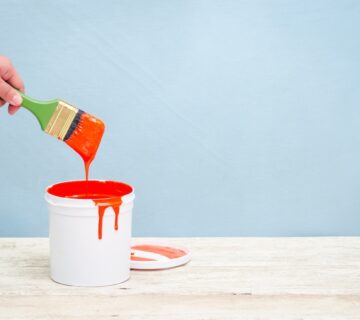Water-based paints have undergone significant advancements since their initial introduction in the 1940s and 50s. Today, these paints have become a preferred option for exterior applications, demonstrating their exceptional versatility and enhanced performance. In contrast, oil-based paints, once the norm, have experienced a decline in popularity due to their susceptibility to becoming brittle and developing issues like cracking and peeling over time. The purpose of this blog is to delve into the intricacies of using both water-based and oil-based paints, providing valuable insights into their unique advantages and limitations.
Advantages and Limitations of Oil-Based Paints
Oil-based paints have long been admired for their unparalleled sheen, offering a sophisticated finish that adds elegance to any surface. Their superior leveling properties, attributed to a longer drying time, result in a smooth and flawless appearance, particularly when applied with a brush. However, these paints emit volatile organic compounds (VOCs), posing environmental concerns and contributing to air pollution. Over time, oil-based finishes are prone to yellowing, a phenomenon exacerbated by recent VOC regulations aimed at reducing environmental impact. Additionally, these finishes tend to become brittle, making them susceptible to chipping and cracking, especially in high-traffic areas. Furthermore, oil-based paints present challenges in terms of cleaning and touch-ups, particularly on surfaces like cabinetry.
Benefits and Shortcomings of Waterborne Paints
Conversely, waterborne paints have gained popularity due to their superior durability and environmental friendliness compared to oil-based alternatives. They dry quickly, do not yellow over time, and are easier to touch up. Moreover, their water-based cleanup process is efficient, and the finish is simple to maintain. However, waterborne paints have their limitations. They do not level as smoothly as oil-based paints, often revealing brush strokes and stipple when applied by hand. Additionally, their sheen may not achieve the same refined appearance as oil-based paints.
Emerging Trend of Hybrid Water-Based Enamels
An emerging trend in the paint industry is the development of hybrid water-based enamels, also known as modified alkyds. These products offer a compromise by combining the benefits of water-based paints with the improved leveling capability of traditional oil-based paints. With a slightly slower drying time compared to waterborne paints, hybrid enamels provide enhanced leveling, durability, ease of application, and aesthetic appeal. Homeowners and professionals alike are increasingly turning to these hybrid enamels for their versatility and performance in various painting applications.
Personal Preference in Historical Settings
In historical homes where authenticity is paramount, oil-based paint remains a preferred choice, particularly for trim work and hand-painted surfaces. The use of oil-based paint can help maintain the historical integrity of these properties while providing a finish that complements the architectural style. Consistency in finishes is essential, especially when matching new applications to existing hand-painted oil-based surfaces. However, some homeowners may opt for waterborne paints in historical settings, particularly if they prioritize environmental sustainability or ease of application.
Final Thoughts
Selecting between water-based and oil-based paints involves considering various factors, including environmental impact, desired finish, and project requirements. Seeking expert advice can help homeowners make informed decisions based on their specific needs and preferences. Whether aiming for durability, environmental sustainability, or historical accuracy, the right choice of paint can enhance the beauty and longevity of any project. By understanding the advantages and limitations of different paint types, homeowners can achieve optimal results and create spaces that are both aesthetically pleasing and functional. For more detailed insights and guidelines, visit sisupainting.com and explore our blog at sisupainting.com/blog for valuable painting tips and information.




Such an amazing blog, I love reading all your blogs. They are super amazing and informative at the same time. Bookmark your page already, keep posting more.